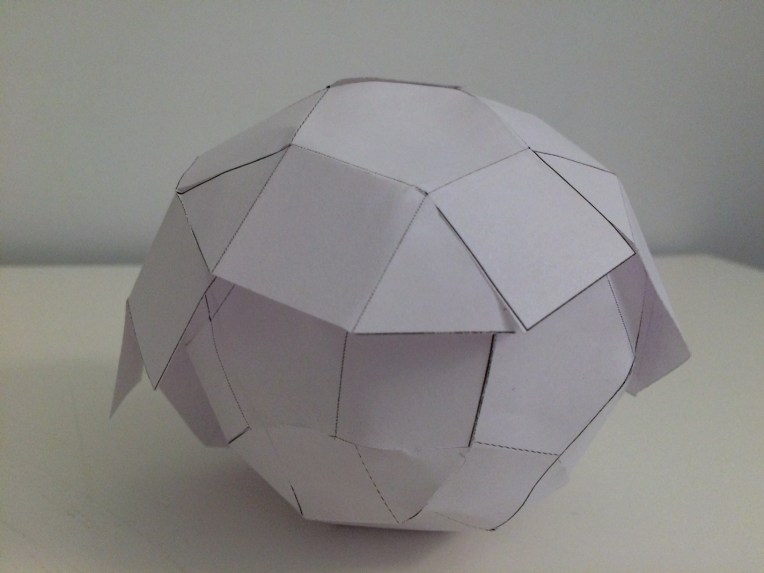WEEK 5 (Prototype)
I decided to focus on the Karakuri mechanical box, so I can explore the mechanics of gears and translate the paper form to a wooden version. To help me get started, I used the paper templates from the book,
Karakuri: How to Make Mechanical Paper Models Move. I was able to cut and assemble a paper model of the box and gears as the start of my prototype.
• • • • •
WEEK 6 (The Construction)
The next steps for me was to draw the flat pieces into a digital vector format so I could easily adjust the pieces into an updated design using wood with a 1/4″ thickness.
1) Taking the box apart and measuring the individual pieces to translate them into a vector form in Adobe Illustrator. (TIP: When I used a regular ruler to measure, it was a little frustrating to get precise measurements. Instead, I used a precision ruler that I’ve had for years to help me measure the exact fractions. And when I need to convert the fractions to decimal points quickly, I keep a conversion chart of fractions to decimals by my desk and in my sketchbook.
2) Template in Illustrator and making gears: I struggled with drawing the gears but after watching some YouTube videos, I figured out some quick and less frustrating tips in gear making. Start with 2 circles (diameter, diameter with length of teeth), then a star (to help guide the placement of the teeth), use the ‘Outline’ tool in the ‘Pathfinder’ tab, ungroup and set the stroke to Black, and delete the lines that are not needed.

3) Testing the template on a vinyl cutter: I tested the template on a vinyl cutter first. This helped me correct template by adding or removing lines that should of been cut versus needed to be perforated. Adjusting my template before trying the template on a laser cutter definitely helps save time. When using the vinyl cutter, I first started off with 100# Bristol paper which required a deep cut blade and I experimented with cutting the template on wood paper as well. The wood paper has a nice finish, but it’s too flimsy and the vinyl cutter didn’t cut all the way through so I needed to over the edges with an Exacto knife. I also need to figure out the correct settings to get the vinyl cutter to cut through thick sheets—I had the same issue with the 100# paper stock.




4) Testing the template on the laser cutter and more prototypes: Translating the flat pieces to something that has depth, particularly the 1/4″ thickness of the wood. I first tried cardboard and then wood. The challenging part of this task was recreating the box without the paper flaps. After seeing a rough prototype of the wood version and how I glued it together, the thickness of the wood added to the length of the cube and if I glued it that way, I would need to make some ‘sides’ shorter in order to compensate for the added depth. (NOTE: the laser cutter didn’t go through the wood completely after 3 passes and needed to run through the laser cutter a couple more times to cut through the wood. Also book enough time to do this.)



5) Constructing Boxes with Interlocking Edges: I actually tried to construct this last semester for my
PCOM midterm (and before I learned how to use the laser cutter), but I couldn’t get the grooves to match perfectly and ended up buying an acrylic cubed enclosure from The Container Store. I tested a rough version on cardboard with the laser cutter first, but ran into the same problem of figuring out where things should interlock, so I carefully worked on laying out the interlock in Illustrator and spacing the grooves apart by 1/4″ (which is also the same size as the wood thickness). In Illustrator, I also laid out each side of the box like a cross so I could easily see what was connected to what and tested the grooves next to one another. After each round, I tested a paper version on the vinyl cutter a couple times, taped the pieces together and was able to mark with a Sharpie, what grooves were unnecessary or missing to adjust my template.

6) Laser cutting with the final template on “wood”: For this latest version, it took an 1 hour to do 9 passes through the laser cutter. It did cut through to almost everything except for 2 gears with the longer teeth, which were luckily my backup pieces that I didn’t need). I was very happy that the sides interlocked with no missing pieces and decided not to use wood glue to lock them together cause the interlock fits tightly together. On my template, I tried to keep the pieces interlocked while it was laser cut, so the sides would fit together smoothly when constructing the box.


7) Work in Progress: In order for the gear mechanism to work better, I need to make the holes (or squares) in the center of the inside gears and the big circular ‘turner’ smaller and the long beam a little thicker, so it has more tension and doesn’t allow the gear to slide around as much. In the paper version, there were small paper tabs to glue onto the beam to keep things in place. By making the holes a little tighter, I’m hoping that it will keep things in place better. I also want to add a top piece to the box and attach it to the gear mechanism. I was thinking of trying to animate the wheels of a Mars Rover and have little human figures inside the ‘gear’ box, standing on and around the gears to convey the idea of them controlling the Rover’s “movements.”






















































































You must be logged in to post a comment.